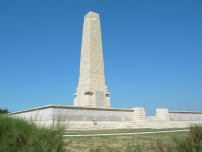| First Name: | Gilbert Henry | Last Name: | WHITFIELD | |
|---|---|---|---|---|
| Date of Death: | 08/08/1915 | Lived/Born In: | Wimbledon | |
| Rank: | Second Lieutenant | Unit: | Indian 14th Sikhs | |
| Memorial Site: | 1. Wimbledon, St Mary 2. Helles Memorial, Gallipoli | |||
Current Information:Gallipoli 1915 On 25 April, British, Australian and New Zealand forces landed on the Gallipoli peninsula. The plan was that these forces would soon defeat a demoralised Turkish army, knock Turkey out of the war, open up the Mediterranean to the Russian navy and threaten Austro-Hungary from the south. None of these things were achieved despite nine months of hard fighting in terrible conditions. It was a heroic failure. By July, 1915, and after much fierce fighting, stalemate had set in at Gallipoli both at Cape Helles where the British and French had landed and at Anzac Cove where the Australian and New Zealand Corps were unable to break out of their beach head. Fresh troops were needed and they were on their way in the shape of four divisions from Britain and things were put on hold until they arrived. The plan for August was for a landing at Suvla Bay to the north of Anzac Cove whilst at the same time, the ANZAC Corps, reinforced by some of the new British troops would effect a breakout from Anzac Cove and establish a line across the peninsula. Whilst this was going on the troops in the south at Helles would stage a number of diversionary attacks. But it all went horribly wrong and much of the reason for this can be explained by inadequate planning and leadership. Nobody seemed to know what they were supposed to be doing and Lieutenant-General Stopford, in charge of the Suvla landings was particularly out of his depth. The landings at Suvla failed to link up with the forces at Anzac and the breakout from there did not happen despite valiant efforts by all concerned. The loss of life on all fronts was again enormous. L.A. Carlyon’s excellent book “Gallipoli” gives a superb yet chilling account of the events.
The 29th Indian Infantry Brigade landed at Helles on 1st May, 1915 and became an extra Brigade in the 29th Division. They remained at Helles until the night of 5/6th August when they landed at Anzac Cove to take part in the attack there. The14th Sikhs and 5th Gurkhas formed the third column of the left attacking force which would make their way northwards up the coast before turning inland to attack the heights of Sari Bair from the north with the final objective of capturing Hill 971. The immediate objective of the third column was the northern peak of Hill Q. Setting off the following night the whole of this force, including the Indian Brigade, soon found themselves in trouble. It was pitch dark and the terrain they had to cross was extremely difficult and confusing with deep gullies and steep ridges branching off in all directions. There were no maps to assist them nor had the ground to the north of the ANZAC beach head been reconnoitred. It was no wonder that they got lost. Wrong turns were taken, units became scattered and there was little or no chance that the heights of the Sari Bair range would be reached, let alone captured the following day. For the next two days the Indian troops of the third column made little or no progress and were further discomforted by Turkish snipers occasionally firing on them from the surrounding hills. Gilbert Whitfield was killed on 8th August and it is likely that he was a victim of a sniper’s bullet. |
||||
| « Back to Search Results | ||||
| If you think any of the information shown here is incorrect, Click Here to submit your amends and comments | ||||




